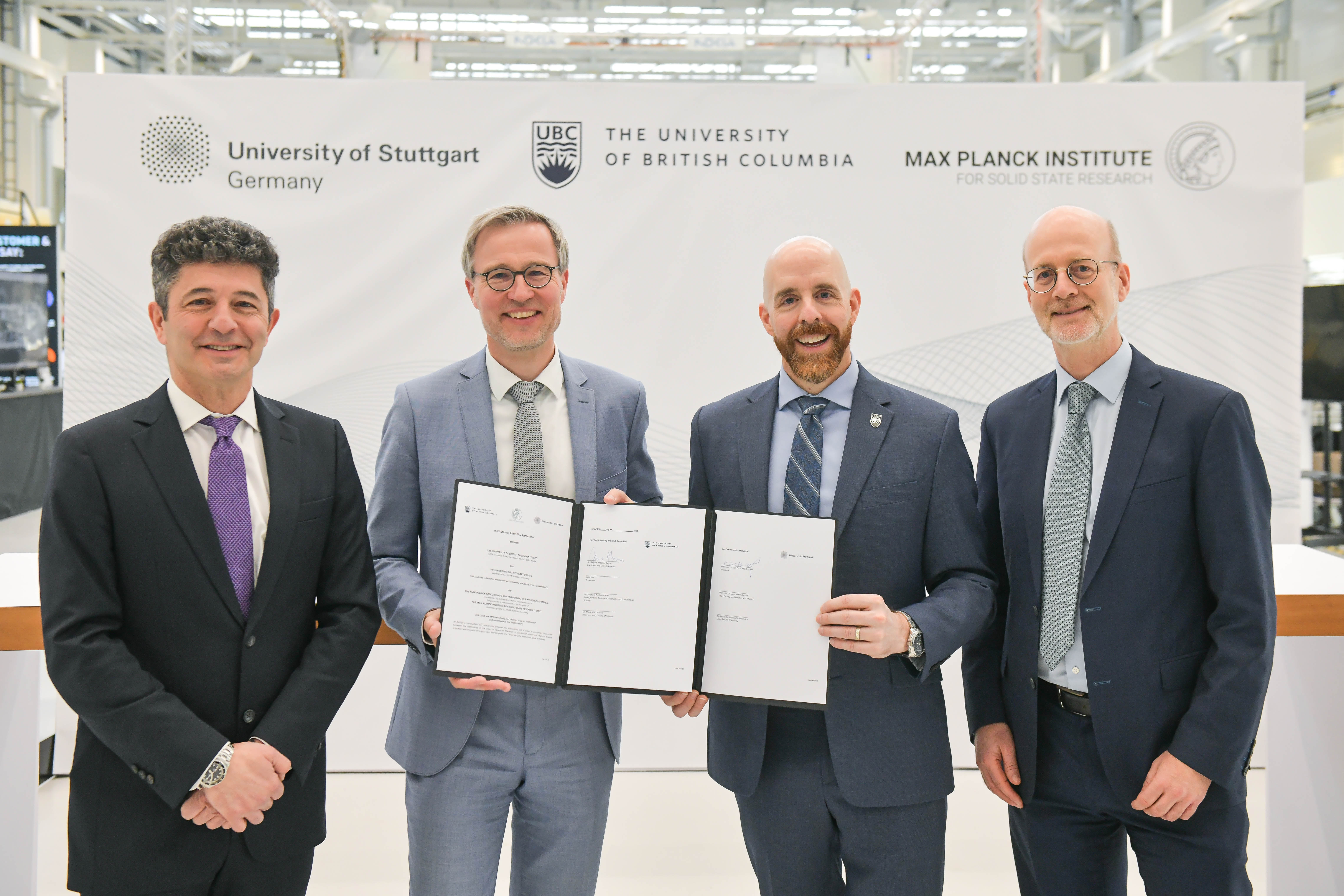UBC, the University of Stuttgart and the Max Planck Institute for Solid State Research (MPI-FKF) announced Jan. 20 the extension of their international joint PhD program in quantum materials and material science.
UBC President and Vice-Chancellor Benoit-Antoine Bacon, University of Stuttgart Rector Prof. Peter Middendorf, Director of the MPI-FKF Prof. Bernhard Keimer and UBC Blusson QMI Scientific Director Andrea Damascelli attended the formal signing ceremony hosted by the University of Stuttgart Jan. 20 in Germany. The day-long visit by the UBC delegation to Stuttgart also provided an opportunity to deepen existing collaborations and explore new areas for partnership.

Pictured from left to right: Prof. Andrea Damascelli, Scientific Director of UBC`s Stewart Blusson Quantum Matter Institute, Prof. Peter Middendorf, Rector of University of Stuttgart, Prof. Benoit-Antoine Bacon, UBC President and Vice-Chancellor, Prof. Bernhard Keimer, Director of the Max Planck Institute for Solid State Research (photo: Max Kovalenko/University of Stuttgart)
“This contract extension is truly a reason to celebrate,” said Rector Middendorf. “The Joint PhD Program not only fosters the exceptional professional and personal growth of the participating early-career researchers, but also represents a vital contribution to scientific progress through successful international collaborations. For the University of Stuttgart, international networking in teaching and research holds strategic importance—such networking thrives on personal exchange. With its forward-thinking research profile and outstanding global reputation, UBC is an especially significant partner for us. We are therefore all the more delighted to welcome such a distinguished delegation from UBC to Stuttgart today as we explore further opportunities for collaboration together.”
Said UBC President and Vice-Chancellor Bacon: “UBC and the University of Stuttgart have developed a strong partnership characterized by cutting-edge research collaborations, academic exchanges, joint academic programs, mobility initiatives and a shared commitment to addressing global challenges. The joint PhD program, led in collaboration with the Max Planck Society, is a cornerstone of our partnership, reflecting a shared commitment to advancing excellence in research, innovation and education.”
Said Bernhard Keimer, Director of the Max Planck Institute for Solid State Research: “The Joint PhD program has allowed us to attract outstanding young scientists to our collaboration.”
The visit by the UBC delegation to the University of Stuttgart and Max Planck Institute for Solid State Research underscores the mutual commitment to expanding linkages in research, teaching and transfer. In addition to the celebrations to mark the extension of the joint PhD program, the event also served to deepen existing collaborations and explore new opportunities, such as architecture and adaptive buildings, bionic intelligence, hydrogen technologies, democracy and digital societies.
UBC, University of Stuttgart and the Max Planck Institute for Solid State Research announced the extension of their international joint PhD program in quantum materials and material science (Video: Stewart Blusson Quantum Matter Institute/YouTube)
In addition to presentations by researchers from the University of Stuttgart, the program included a guest lecture by the German Aerospace Center (DLR). The UBC delegation toured the Max Planck Institute for Solid State Research and the research campus ARENA2036, a world-class research and innovation platform driving advancements in future mobility, lightweight construction and digital production through interdisciplinary academic and industrial partnerships.
During the visit, the partners exchanged views on cooperation formats in teaching and research, some of which have been in place for many years. In the area of student mobility, for example, there has been an exchange for both student and research stays for years, partly financed with scholarships through Erasmus+ KA171 Worldwide. There are joint research projects in a wide range of areas, including in the IntCDC or SimTech clusters of excellence, aerospace engineering in cooperation with DLR and in the field of hydrogen technologies.
Research in quantum materials promises transformative applications in healthcare, computing, defence, advanced sensing and sustainable energy. The joint PhD program offers opportunities for research training in quantum materials and quantum materials-based devices. The highly collaborative nature of the program exposes graduate students to a wide range of topics in material systems beyond their immediate research projects, positioning them to contribute to the rapidly evolving research frontier and emerging industry.
“Thanks to the program, I can conduct research for my doctoral thesis at more than just one research facility and in more than just one country,” said participant Cissy Suen. “This gives me access to more laboratories, more knowledge and a larger network.”
The renewal of the Joint PhD agreement in early 2025 coincides with the United Nations’ designation of 2025 as the International Year of Quantum Science and Technology, commemorating a century since the inception of quantum mechanics.
Read more about UBC's growing relationship with Germany.
